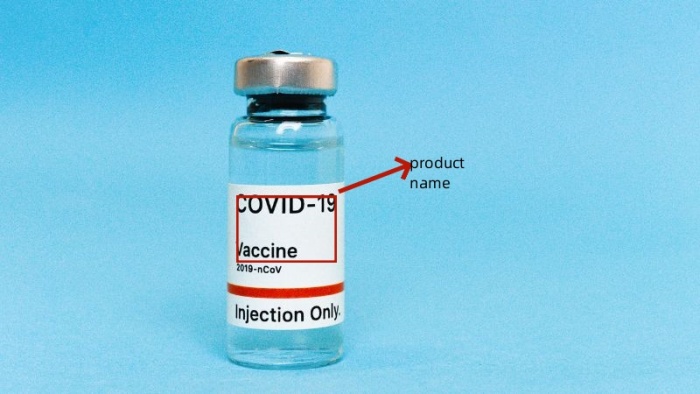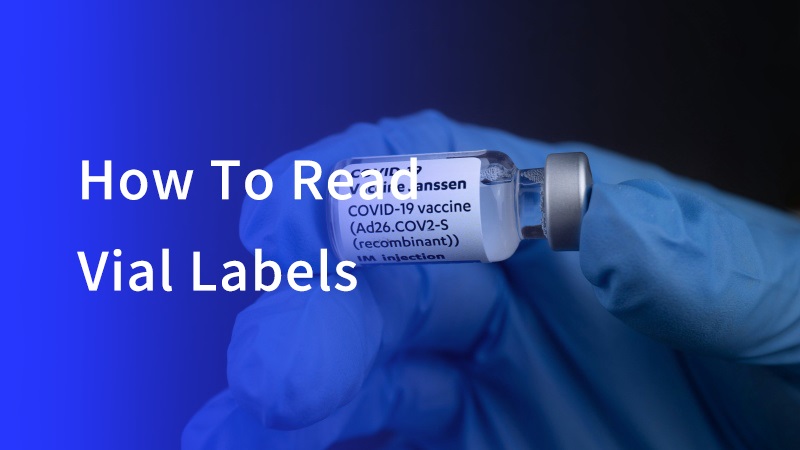Why are those vial labels so important? Well, they’re like secret codes that tell doctors and nurses everything they need to know about the medicine inside.
In this guide, we’ll learn how to read vial labels.
Basics of vial labels
Vial labels are designed to communicate essential information at a glance. Key components typically include:
- Product name: The commercial name or chemical identity.
- Ingredients: The main ingredient is the part that makes the medicine work. Other ingredients, which are not as important for the treatment, can sometimes cause allergies in certain people. These extra ingredients don’t help with the healing process but are still part of the medicine.
- Dosage information: Concentration and volume within the vial.
- Lot number: A unique identifier that manufacturers use to track production batches.
- Expiration date: The date after which the vial should not be used.

Understanding symbols and colors is important. Because they give quick clues about what’s inside:
Red: Shows immediate dangers like being very toxic or able to catch fire easily.
Green: Tells that the contents are safe or need special handling instructions.
Steps in reading vial labels
To read vial labels effectively, follow these steps:
Step1-Start at the top
It is important to begin by looking at the product name on the medicine bottle or vial. This helps make sure you have the right medicine in your hands.
Sometimes, different medications can look similar, so always check the name first to avoid using the wrong one. This is the first step to staying safe when using any kind of medicine.
Step2-Check the ingredients
After checking the name, the next step is to look at the ingredients. You want to make sure that what’s inside the bottle is right for what you need. Some people can be allergic to certain ingredients in medicines, so it’s important to know what’s inside.
The ingredients list can also tell you what the main active ingredient is, which helps you understand how the medicine works. If you are not sure about an ingredient, it’s a good idea to ask a doctor or pharmacist.
Step3-Verify dosage and volume
The amount of medicine you take is very important. After checking the ingredients, you need to look at the dosage and volume information. Dosage tells you how much medicine you should take at one time, and volume tells you how much liquid or how many pills are in the container.
It’s easy to make mistakes with this, so always double-check to make sure you are taking the right amount. Taking too much or too little could be harmful, so be careful to get it right.
Step4-Lot number and expiration date
Every bottle of medicine has a lot number and an expiration date. The lot number is important because it allows the manufacturer to trace the batch the medicine came from. This is helpful in case there’s ever a problem with the medicine, such as a recall.
The expiration date tells you how long the medicine will work well. Taking medicine that is past its expiration date might not help you and could even be dangerous. Always check these two things before using any medicine to make sure it’s safe to use.
Step5-Pay attention to symbols and colors
Medicines often come with symbols or colors on the packaging. These symbols are there to give you important information quickly. For example, a red symbol might mean that the medicine is dangerous if not handled carefully.
Green symbols could mean that the medicine is safe when used as directed. Paying attention to these visual clues helps you use the medicine properly and safely. If you don’t understand what a symbol means, ask someone who can explain it, like a doctor or pharmacist.
Step6-Understand the medication
It is very important to read and understand everything on the label of the medication. The label will tell you who made the medicine, how much to take, and how to take it.
It might also include warnings or special instructions, like whether you need to take the medicine with food or avoid certain activities after taking it.
The more you know about the medication, the safer you will be when using it. Labels can also tell you if the medicine should be stored in a special way, like in the refrigerator.
Step7-Consult your healthcare provider
If you have any questions or are unsure about anything on the label, it’s important to talk to your doctor or pharmacist. They can help explain anything you don’t understand and make sure that you are using the medicine the right way.
If you are ever unsure, it’s always better to ask rather than risk taking the medicine incorrectly. Your healthcare provider can also give advice on what to do if you miss a dose or have a side effect. Keeping in touch with your doctor helps you stay on track and recover faster.

Practical tips and tools for managing vial labels
To assist with reading vial labels, consider the following tools and tips:
- Magnifying glass: Use this tool to read small print clearly.
- Barcode scanners: These can quickly retrieve and verify information from the label’s barcode.
- Regular training: Stay updated on best practices and changes in labeling standards.
- Consult your pharmacy: They can help you understand and interpret medication labels correctly.
- Check for interactions with other drugs: Always review the label for any warnings about interactions with other medications you may be taking.

Conclusion
Properly reading a medication label is more than a routine task; it is an essential skill that affects the safety and well-being of individuals.
By understanding and applying the information outlined in this guide, one can significantly reduce the risk of errors and ensure that substances are used safely and effectively. Always consult a healthcare provider for proper medication use to aid recovery and reduce unnecessary medical visits.
Always remember, that taking the time to read and understand vial labels can make a significant difference in clinical and laboratory settings.
Viallabeller is customized for vial labeling and has a range of labeling solutions(like ampoules, syringes, etc.). If you are interested, you can contact us!







